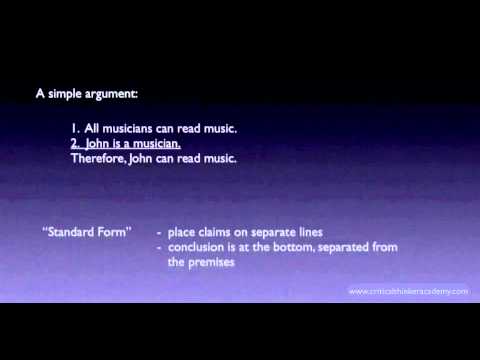4.41: Text- Logical Arguments
- Page ID
- 59066
Anything you read that includes an attempt to persuade you to think a certain way is likely to include logical argument as part of that persuasion.
The text below introduces the idea of premises and conclusions. As you view this, think about the relationship of premises and conclusions as they align with main ideas and supporting evidence in paragraphs that we explored earlier in this module.
Elements of an Argument
Argumentation Vocabulary
Claim: a statement or opinion that is either true or false
Argument: a claim supported by premises
Conclusion: the main claim in an argument
Premises: claims that support and argument’s conclusion
A claim is an assertion about the truth, existence, or value of something that is either true or false. Claims are also called statements or propositions.
When supported by premises, a claim becomes a conclusion. For example:
- This class is easy.
- The Detroit Lions have the potential to make the NFL playoffs.
- This chemical structure is unstable.
- Democratic socialism is superior to a pure democracy.
An argument is an assertion that contains both a conclusion and premises. It is a statement of fact or opinion that is based on evidence. Keep in mind that not all statements are arguments, and some statements may contain multiple arguments.
Test It Out
Which of the following statements is an argument?
- Vending machines stocked with soda or candy should be removed from all public schools.
- Star Wars is the best movie ever.
- We’d better leave now. If we don’t, we might miss the last train and we’ll be stuck here all night.
[reveal-answer q=”170878″]Show Answer[/reveal-answer]
[hidden-answer a=”170878″]If you answered #3, then you are correct! The first and second statements are not arguments because they offer no support. The third statement is an argument because it offers support (premises) to support the claim.[/hidden-answer]
A conclusion is the main claim of an argument that is supported by a premise. It is the logical result of the relationship between the premises. Identifying the conclusion is the first step in understanding the argument.
But how do you identify the conclusion? Follow these steps:
- Ask, “Is the statement the main point, or is it a claim given to support another statement in the argument?
- Identify the indicator word that often precedes the conclusion, such as
| Therefore | Thus | As a result | That’s why | Consequently | So |
| This Means | This shows | It follows that | This suggests | Hence | Accordingly |
Test It Out
What is the conclusion in each of the following arguments?
- Abortion is wrong because all human life is sacred.
- It’s flu season and you work with kids, so you should get a flu shot.
- We should believe that rocks exist because we are able to see them.
- John will probably receive the next promotion since he’s been here the longest.
- We must reduce the amount of money we spend on space exploration. Right now, the enemy is launching massive military buildup, and we need additional money to purchase military equipment to help match the anticipated increase in the enemy’s strength.
- It’s a beautiful day. We should go to the park. Besides, I need some exercise.
- That movie has had horrible reviews. My sister saw it and said it was boring and her friend spotted three mistakes. Pick a different movie. I am sure we can find something better.
[reveal-answer q=”576671″]Show Answer[/reveal-answer]
[hidden-answer a=”576671″]
- Conclusion: Abortion is wrong.
- Conclusion: You should get a flu shot.
- Conclusion: Rocks exist.
- Conclusion: John will receive the next promotion.
- Conclusion: We must reduce amount of money we spend on space exploration.
- Conclusion: We should go to the park.
- Conclusion: We should pick a different movie.
[/hidden-answer]
A premise is a reason offered as support, or evidence, for another claim. It is often indicated by these words:
| Because | For | As |
| Since | Inasmuch as | As shown by |
| Given that | As indicated by | The reason is that |
Consider the following statement: Today’s freshmen cannot write very well. Joe is a freshman, so he must be a poor writer. The premises and conclusion are identified as follows:
| Premise | Today’s freshmen cannot write very well |
| Premise | Joe is a freshman, |
| Conclusion | so he must be a poor writer. |
Practice identifying the premises and conclusions
In order to identify the premises and conclusion, you should first rewrite the argument in standard form. You do this by identifying which claim is the conclusion, then working backwards to identify which claims are premises that support the conclusion. It should look like this:
| Standard Form | |
| Premise 1: | |
| Premise 2: | |
| Conclusion: | |
Practice in the following presentation:
An interactive or media element has been excluded from this version of the text. You can view it online here: http://pb.libretexts.org/braw/?p=204
- Revision and Adaptation. Provided by: Lumen Learning. License: CC BY-SA: Attribution-ShareAlike
- Understanding Logical Argumentation, Structure, and Reasoning, modified. Authored by: mrbelprez. Located at: http://www.slideshare.net/mrbelprez/part-2-5-fixed-all-sections-2014-logic-and-argumentation. License: CC BY-SA: Attribution-ShareAlike
- What is an argument?. Authored by: Kevin deLaplante. Located at: https://youtu.be/Nq8-w2BAJkU. Project: Critical Thinking Academy. License: All Rights Reserved. License Terms: Standard YouTube License


